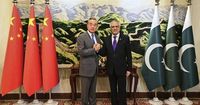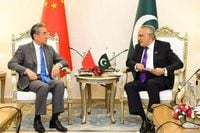On August 21, 2025, the diplomatic heart of Islamabad pulsed with anticipation as Chinese Foreign Minister Wang Yi and Pakistan’s Deputy Prime Minister and Foreign Minister Ishaq Dar shook hands, reaffirming a partnership that has become a linchpin in South Asian geopolitics. Their meeting, held at Pakistan’s Ministry of Foreign Affairs, was more than a ceremonial gesture—it signaled the launch of a new chapter for the China-Pakistan Economic Corridor (CPEC), the flagship project of China’s sweeping Belt and Road Initiative (BRI).
According to the Associated Press, both sides agreed to kick off a series of new projects under the CPEC banner, though the specifics remain under wraps for now. This comes at a time when CPEC, which was inaugurated in 2015, has already funneled billions of dollars into Pakistan’s infrastructure, building roads, power plants, and railways that tether China’s western Xinjiang region to the Arabian Sea port of Gwadar in southwest Pakistan. The corridor, a central artery of the BRI, has not only deepened economic ties between the two nations but has also become a symbol of China’s growing global ambitions.
Yet, the progress has not been without turbulence. As reported by Arab News, Pakistani foreign policy analysts have urged the government to make “serious efforts” to ensure implementation of long-delayed CPEC projects. These include the establishment of special economic zones (SEZs), modernization of the country’s railway lines, and a bold extension of the corridor into Afghanistan. The hope, experts say, is that these projects will help revive Pakistan’s struggling economy, which has been battered by political instability, energy shortages, and recurring security threats.
Shakeel Ramay, an economist cited by Arab News, pointed out that SEZs—a key promise of CPEC—have lagged behind due to governance and political challenges. “The positive point is that the government has now realized their importance and is working on it, but serious efforts are needed to expedite the implementation,” Ramay said. He also highlighted the Main Line-1 (ML-1) railway project, a $6.7 billion upgrade of the 1,687-kilometer Karachi–Peshawar rail artery, as a linchpin for Pakistan’s economic revival. The ML-1, first agreed upon in 2017, is expected to double tracks, introduce advanced signaling, and boost both cargo and passenger capacity, making it easier to move goods from Pakistan’s southern ports to the nation’s commercial heartland.
Gwadar, the jewel in CPEC’s crown, has seen tangible progress despite the obstacles. In January 2025, Pakistan operated its first commercial flight at the newly built Gwadar International Airport, a project funded by China. The Chinese government has also donated 5,000 solar units, built a state-of-the-art hospital, and—alongside Pakistani partners—invested nearly 3 billion Yuan ($418 million) in the Gwadar Free Trade Zone. “Implementation of CPEC projects in Gwadar is visible, despite hurdles,” Ramay observed, noting the palpable impact on the local community.
Still, the corridor’s expansion faces formidable headwinds. Security remains a persistent concern, particularly for Chinese workers and engineers who have been targeted by separatist militants in Balochistan and other regions. Both governments have responded by tightening security protocols, with Pakistan deploying advanced technology, ramping up intelligence sharing, and engaging local communities in CPEC areas. Dr. Talat Shabbir, director of the China-Pakistan Study Center, told Arab News, “Looking ahead into 2025, Pakistan is further upgrading its security protocols with a mix of technology, intelligence sharing, and community-level engagement in CPEC areas.”
The strategic dialogue in Islamabad was just one stop on Wang Yi’s five-day tour of South Asia, which included visits to India and Afghanistan. The regional context is crucial. At a joint news conference, Wang described China and Pakistan as “ironclad friends and all-weather strategic partners.” He stressed that CPEC is not merely a bilateral venture but a project that “will benefit not only people from China and Pakistan but also those in Afghanistan and beyond,” as reported by China Daily.
Indeed, the corridor’s potential extension into Afghanistan was a hot topic during the trilateral talks in Kabul on August 20, 2025, which brought together the foreign ministers of China, Pakistan, and Afghanistan. The three nations agreed to strengthen economic, trade, and security cooperation and to explore ways to link Afghanistan to the corridor. Yet, as Naghmana Hashmi, Pakistan’s former ambassador to China, told Arab News, “Without a peaceful Afghanistan and secure transit, CPEC could not completely develop for Pakistan.” While the Taliban government in Kabul has warmed to the idea, persistent tensions between Islamabad and Kabul—particularly over cross-border militancy—mean that extending CPEC northward will be no easy feat.
The recent push for “high-quality” cooperation under CPEC, often dubbed “CPEC 2.0,” is intended to address some of the shortcomings and delays that have plagued the project. During the fourth cycle of diplomatic talks in Beijing on August 20, 2025, Chinese Vice Foreign Minister Sun Weidong and Pakistan’s Foreign Secretary Amna Baloch agreed to upgrade the corridor, with a renewed focus on industrialization, clean energy, agriculture, and livelihood projects. As DW reported, both sides reiterated their resolve to elevate their “ironclad ties to a new pedestal of cooperation and collaboration.”
But the road ahead is anything but smooth. Pakistan’s economic hopes are riding on the promise of greater Chinese investment, but political instability and energy shortages continue to stymie progress. The challenges are not merely technical or financial—they are deeply human. Earlier in August, frustration boiled over in Gilgit-Baltistan, where hundreds of protesters blocked a section of the Karakoram Highway (a vital CPEC route) to protest crippling power outages. With blackouts lasting more than 20 hours and temperatures plunging to -15 degrees Celsius, locals’ anger was palpable. The protests halted dozens of freight trucks from crossing into China, underscoring the fragility of the corridor’s infrastructure and the urgency of delivering on its promises.
Amid these trials, both nations have doubled down on their partnership. Wang Yi emphasized that China’s relations with South Asian countries, including India and Pakistan, are “not directed against any third party.” Rather, the focus is on fostering regional stability, prosperity, and a multipolar world order. At the same time, Pakistan’s government has pledged to combat terrorism and ensure the safety of Chinese institutions and personnel, a commitment that is as much about safeguarding foreign investment as it is about national security.
With the world’s eyes on South Asia, the stakes for CPEC’s next phase couldn’t be higher. The corridor’s success—or failure—will not only shape the economic future of Pakistan but could also redefine the contours of regional cooperation, connectivity, and competition for years to come.

